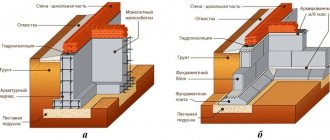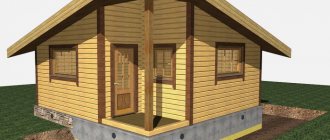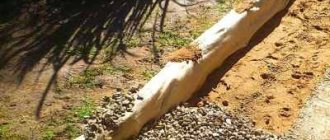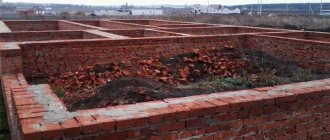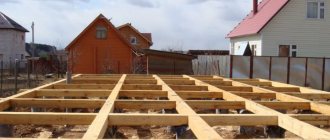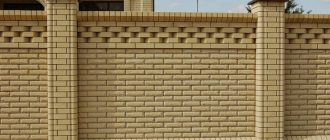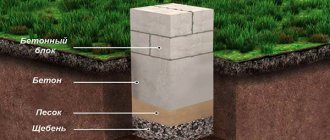Compaction of soil with crushed stone is required in cases where the foundations do not have sufficient load-bearing capacity to build buildings or lay roads on them. There are such soils that it is impossible to even walk on them. They also need to be compacted. In this article we will tell you which crushed stone is best suited for such purposes, how to choose it and how to carry out the work correctly. Finally, we will briefly describe alternative materials for soil compaction.
At the Soil Trucks company you can buy crushed stone for soil compaction with delivery to your site at the lowest price.
Price for crushed stone for soil compaction from 490 rubles. for 1m3 Order
Preparing the site for the foundation: why is it needed?
Like every type of our activity, creating the foundation of a house requires a thorough and comprehensive preparatory process based on knowledge of the basic characteristics of the soil. Since the soil in different areas, and even within the same territory, can be very different, it is a good idea to understand which design is best suited for your plot of land.
Preparing the soil for the foundation is designed to ensure the stability of the cottage’s foundation, to provide more points of support with maximum strength, not subject to internal and external influences. Loose soil cannot be the basis for the construction of a structure, since under the weight of the structure it will invariably sink to the depth at which it can compact itself. And it is more expensive to build houses on moving soils, because uneven shrinkage will lead to disruption of the geometry of the structure, the structural integrity of load-bearing structures, cracks and destruction.
In addition, the constructed structure will be affected by soil pressure, the effect of heaving from the frozen soil, underground water flows - as a result, there will be flooding, waterlogging, and even a displacement of the house from the original construction site by several meters in different directions depending on the time of year.
Preparing the soil for the foundation is designed to eliminate any negative influences coming from outside, to provide a strong and stable foundation for structural elements, and to speed up the process of constructing a country residence. After all, on a prepared foundation it will be much easier to erect the main structure of the foundation, which will not need much time for final shrinkage.
The vibrating and tamping tool used, even with normal manual action, is capable of transmitting a pressure force to the soil much greater than the weight of the person carrying out the work. The more densely the surface and deep layers are compacted, the less time it will take for the house to finally fall into place and not be exposed to the forces of nature.
Work order
Under ideal conditions, design documents reflect all the requirements for backfilling, but such corrosiveness is rarely encountered today. There is a general procedure for backfilling soil.
- Cleaning a trench or pit from foreign objects and construction debris. Without this, backfilling cannot begin.
- Assessment of soil moisture. The best indicators for heavy soils are 20% humidity, for heaving soils – within 12–15%. The soil should not be too dry or muddy. If necessary, it is brought to the desired state.
- Laying a layer of sand. Its thickness should be from thirty centimeters to half a meter.
- Direct backfill. It is produced gradually in layers, while constantly tamping each of them.
It is worth talking in more detail about compaction technology.
How to prepare the soil for the foundation?
All the most interesting things begin with geological surveys, which allow the architects and designers of our company to determine the degree and volume of preparatory work, based on the characteristics of the future cottage, its size and the required technical parameters. The process then looks like this:
- Marking on the ground the territory that will be given over to the construction of the foundation. In this case, it does not matter at all what type of foundation is chosen for the cottage - it is necessary to determine the boundaries of the future structure with the help of markers and stretched twine;
- The top layer of soil is removed - as a rule, at least to the depth of the fertile layer, on which structures are never built. This process uses manual excavation or special equipment - a bulldozer and an excavator. It is worth noting that in order to pour a monolithic foundation, the price of excavation work will be higher, since significant volumes of soil will have to be removed from the entire building area;
- After removing the earthen layer, you need to go deeper to the calculated level of the foundation base. Most often, it is located below the freezing edge for each individual region, but the presence of groundwater can correct the position of the base, or even completely change its appearance. In order to avoid surprises in the process of organizing the pit, geological surveys are carried out on the ground;
- For slab and strip foundations, the width of the pit should be greater than the very foundation of the house in order to create a sufficiently wide and stable cushion. If necessary, the walls of the pits are strengthened with shields or piles, which can then be dismantled;
- Separately, we note that the price for installing a pile foundation does not include excavation work, since the driving of supporting structures is carried out into deep layers, which, due to their tectonic characteristics, are already quite strong and stable. The process of installing a screw-type base occurs in exactly the same way;
- Preparing the base for the foundation by compacting the soil layer using special equipment and mechanical devices - vibrating tools, hand rollers. When performing this process, one should take into account the characteristics of different soils, which require a special approach to the processes of compacting their structure;
- Creating a cushion for the foundation - concrete or sand-crushed stone, 10-20 centimeters wider than the foundation itself. The final stage of finishing the base depends on this variety. Whatever the option, it is very important to constantly check the level of the resulting site using special measuring instruments - you may need to add soil somewhere or, conversely, remove a little.
- After this, formwork is installed on the cushion and the bulk of the monolithic mixture is poured. The stability of the foundation itself also depends on the quality of the compaction of the cushion, since sand with crushed stone or concrete preparation must lie perfectly evenly - according to the level marked by measuring instruments.
Advantages of buildings on a sand bed
Among the numerous advantages that are worth noting when using sand cushion technology, it is almost impossible to single out the main and minor ones. Each individual characteristic makes its own unique “contribution” to the strength and reliability of the entire structure. The first and obvious advantage of a sand cushion is its low cost and simplicity of all work on the device, which will require a minimum amount of time.
A house with such a foundation can be built on almost any soil - weak, watery or heaving. At the same time, the service life of the building can be significantly increased if high-quality geotextiles are placed under the cushion, and a high-quality drainage system is provided at the site where construction is taking place. As a result of this, such common problems with a new home will be eliminated, such as:
- the formation of cracks in the walls and the foundation itself, caused by uneven shrinkage of the building;
- freezing of the foundation and, as a result, an increase in the cost of heating the house;
- accumulation of water in basements, often observed in houses located in areas with high groundwater levels, especially in spring;
- constantly high humidity, which is observed throughout the house, and not just in the basement, which leads to the formation of mold, damage to furniture, and various allergic reactions among residents;
- the need to install a serious supply and exhaust ventilation system, the cost of installation and operation of which can amount to quite decent amounts.
How to prepare soil for a foundation: by soil type
Depending on the physical and mechanical characteristics of the soil layer, there are several ways to compact its composition. Naturally, this work should be entrusted only to professionals who know exactly the sequence of action and calculate the intensity of external influence. But to understand the process itself and the equipment used, we will describe several techniques used in work when soil preparation for a foundation is required:
- Deep impact, in order to create not only a durable surface layer, but also to press all internal layers, is carried out by generously wetting the pit with water and using vibration equipment;
- Silty, mobile or weak soils can be compacted using special piles from a mixture of denser soil or river sand;
- Forest soddy and soddy-podzolic soils are sometimes sufficient to fill with water and ensure a normal level of drainage. Under its weight, the soil itself will shift, and water will displace internal air masses;
- Peat soils are best compacted using a process of vacuum and electrical osmosis - this is a rather complex and lengthy process, which results in a solid base that is not inferior to clay;
- Sandy soils are compacted using vibration equipment, which intensively affects all layers of the soil - along the surface and inside the structure.
Based on geodetic surveys, the professionals of our company will be able to accurately determine the type of work to be performed and the range of necessary equipment so that the preparation of the foundation for the foundation is successful. In many cases, since the soil structure is never uniform, it is sufficient to artificially flood the pit, which is then drained naturally or using drainage. The soil begins to compact under its own weight and does not require additional external influence.
Features of sand compaction
Tamping sand with your own hands has some nuances that should be taken into account when creating a solid foundation for a concrete slab.
First of all, you should decide on the type of sand that is best suited for these purposes. It is better to use gravelly material, but it is not recommended to use fine sand for compaction. The larger the grains, the greater the compression resistance of the base, which will help avoid shrinkage of the future house or parking area.
If you are planning to build a monolithic structure, then it is best to give preference to river or quarry sand of the middle fraction. However, even in this case, the underlying layer will be influenced by groundwater. Therefore, in order to prevent the process of erosion of the base, it is necessary to lay geotextiles at the bottom of the trench, and only after that add sand.
In addition, before adding sand, it must be sifted, since the presence of foreign impurities (especially clay) can affect its properties. Monitor the moisture level of the material; the ideal consistency will be if you can roll the sand into a small ball that will not crumble immediately. Accordingly, the sand moisture level should be in the range of 8-14%.
Accordingly, 50% of the successful laying of a gravel-sand cushion depends on the material itself, the remaining 50% comes from the equipment. As mentioned earlier, specialized machines can be used for these purposes, but it is much cheaper to make a manual rammer yourself.
Preparing the site for a strip foundation
This type of foundation is perhaps one of the most difficult for builders and installers, as it requires the implementation of certain processes that are not encountered when constructing other types of foundations. The main difficulty is that often the foundation of a cottage requires a fairly large amount of excavation work in fairly cramped conditions, especially when its depth is over 1 meter.
With a shallow location, digging a pit occurs throughout the entire building area, which is immediately included in the prices set for the strip foundation, whether it is the Moscow region or any other region of the temperate zone. When creating deep foundations, you have to use either special construction equipment or manual labor, which affects the final estimated cost.
Be that as it may, it is not worth saving on high-quality soil preparation for the foundation of a country residence - after all, you are building a cottage to live in it for many decades, why initially create sources of problems for construction and subsequent operation.
Contact the specialists of the InnovaStroy company for help in arranging the foundation of your cottage, or order the construction of a turnkey residence, the price of which already includes all excavation and preparatory work. Trust professionals who guarantee the quality of their work, and not artisanal “masters” who promise to do the best for next to nothing.
